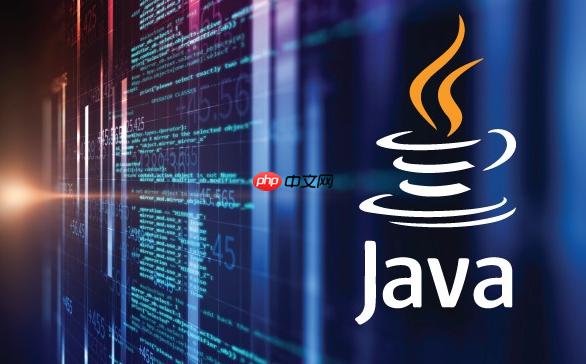java中实现文件复制与移动最推荐的方式是使用java.nio.file包下的files类,因其提供简洁、高效且功能丰富的api,支持权限、原子性及符号链接处理。2. 核心方法为files.copy()和files.move(),均接受源路径和目标路径的path对象,并可选standardcopyoption控制行为,如replace_existing覆盖目标、copy_attributes复制属性、atomic_move确保原子性。3. 文件复制时,files.copy()默认在目标存在时抛出filealreadyexistsexception,可通过replace_existing避免;复制目录仅支持空目录,不递归内容。4. 文件移动本质是复制后删除源,同文件系统内通常为高效原子操作,建议使用atomic_move选项以保证完整性,但需捕获atomicmovenotsupportedexception以应对不支持场景。5. 相较于传统java.io.file,nio.2功能更强、错误处理更细、性能更优,推荐新项目优先使用java.nio.file。6. 大文件操作应避免内存溢出,优先使用files.copy()利用底层零拷贝优化;若需手动控制,可采用缓冲流分块读写或filechannel的transferto()/transferfrom()实现零拷贝。7. 常见陷阱包括权限不足(应捕获accessdeniedexception并预检权限)、原子性缺失(应优先使用atomic_move并设计回退机制)和并发冲突(可通过串行化操作或使用filelock协调,注意其为建议性锁)。8. 所有资源操作必须使用try-with-resources确保流和通道正确关闭,防止资源泄露。综上,使用java.nio.file.files结合恰当的copyoption和异常处理策略,能安全、高效地完成各类文件操作任务。

Java中实现文件的复制与移动,最推荐且功能强大的方式是使用
java.nio.file
Files
要复制或移动文件,核心就是利用
java.nio.file.Files
copy()
move()
Path
Path
StandardCopyOption
Files.copy()
Path
Path
InputStream
Path
立即学习“Java免费学习笔记(深入)”;
示例代码:复制文件
import java.io.IOException;
import java.nio.file.*;
public class FileCopyExample {
public static void main(String[] args) {
Path source = Paths.get("D:/test/source.txt"); // 假设D:/test/source.txt存在
Path destination = Paths.get("D:/test/destination.txt");
Path anotherDestination = Paths.get("D:/test/another_folder/new_file.txt"); // 复制到新目录,并改名
try {
// 方式一:最简单的复制,如果目标文件存在会抛出FileAlreadyExistsException
Files.copy(source, destination);
System.out.println("文件复制成功:" + source + " -> " + destination);
// 方式二:如果目标文件存在,则替换它
// 注意:REPLACE_EXISTING 会覆盖目标文件,但不会覆盖目录
Files.copy(source, destination, StandardCopyOption.REPLACE_EXISTING);
System.out.println("文件(覆盖)复制成功:" + source + " -> " + destination);
// 方式三:复制文件属性(如修改时间、权限等),并覆盖目标
Files.copy(source, anotherDestination,
StandardCopyOption.REPLACE_EXISTING,
StandardCopyOption.COPY_ATTRIBUTES);
System.out.println("文件(带属性覆盖)复制成功:" + source + " -> " + anotherDestination);
// 复制一个目录(注意:Files.copy不会递归复制目录内容,只复制空目录或目录本身)
Path sourceDir = Paths.get("D:/test/source_dir"); // 假设存在一个空目录
Path destDir = Paths.get("D:/test/dest_dir");
if (Files.isDirectory(sourceDir)) {
Files.copy(sourceDir, destDir, StandardCopyOption.REPLACE_EXISTING);
System.out.println("目录复制成功(空目录):" + sourceDir + " -> " + destDir);
}
} catch (FileAlreadyExistsException e) {
System.err.println("目标文件已存在,但未指定REPLACE_EXISTING选项:" + e.getMessage());
} catch (NoSuchFileException e) {
System.err.println("源文件或目标路径不存在:" + e.getMessage());
} catch (IOException e) {
System.err.println("文件复制过程中发生I/O错误:" + e.getMessage());
e.printStackTrace();
}
}
}Files.move()
示例代码:移动文件
import java.io.IOException;
import java.nio.file.*;
public class FileMoveExample {
public static void main(String[] args) {
Path source = Paths.get("D:/test/file_to_move.txt"); // 假设D:/test/file_to_move.txt存在
Path destination = Paths.get("D:/test/moved_file.txt");
Path newLocation = Paths.get("D:/test/another_folder/renamed_file.txt"); // 移动到新目录并改名
try {
// 方式一:最简单的移动,如果目标文件存在会抛出FileAlreadyExistsException
Files.move(source, destination);
System.out.println("文件移动成功:" + source + " -> " + destination);
// 方式二:如果目标文件存在,则替换它
Files.move(source, destination, StandardCopyOption.REPLACE_EXISTING);
System.out.println("文件(覆盖)移动成功:" + source + " -> " + destination);
// 方式三:尝试原子性移动。如果不支持原子性,会回退到非原子操作,或抛出AtomicMoveNotSupportedException
// 原子性移动意味着操作要么完全成功,要么完全失败,不会出现文件部分移动或损坏的情况。
Files.move(source, newLocation,
StandardCopyOption.REPLACE_EXISTING,
StandardCopyOption.ATOMIC_MOVE);
System.out.println("文件(原子性)移动成功:" + source + " -> " + newLocation);
// 移动目录(如果目录非空,可能会失败,取决于文件系统和操作系统的支持)
Path sourceDir = Paths.get("D:/test/old_dir"); // 假设D:/test/old_dir存在
Path destDir = Paths.get("D:/test/new_dir");
if (Files.isDirectory(sourceDir)) {
Files.move(sourceDir, destDir, StandardCopyOption.REPLACE_EXISTING);
System.out.println("目录移动成功:" + sourceDir + " -> " + destDir);
}
} catch (AtomicMoveNotSupportedException e) {
System.err.println("文件系统不支持原子性移动:" + e.getMessage());
} catch (FileAlreadyExistsException e) {
System.err.println("目标文件已存在,但未指定REPLACE_EXISTING选项:" + e.getMessage());
} catch (NoSuchFileException e) {
System.err.println("源文件或目标路径不存在:" + e.getMessage());
} catch (IOException e) {
System.err.println("文件移动过程中发生I/O错误:" + e.getMessage());
e.printStackTrace();
}
}
}说实话,我刚接触Java文件操作那会儿,也只知道
java.io.File
java.io.File
java.io.File
InputStream
OutputStream
boolean
IOException
而
java.nio.file
Path
File
Files
Files.move()
ATOMIC_MOVE
Files.walkFileTree()
NoSuchFileException
AccessDeniedException
FileAlreadyExistsException
java.util.stream
如何选择?
我的建议是:对于所有新的文件操作代码,一律优先使用java.nio.file
java.io.File
想象一下,如果你需要复制一个文件,但又不希望在目标文件存在时直接覆盖,而是希望抛出异常,
Files.copy()
ATOMIC_MOVE
java.io.File
处理大文件,比如几个GB甚至TB的文件,直接一股脑地读进内存显然是不现实的,内存溢出(OOM)是分分钟的事情。
Files.copy()
1. 利用Files.copy()
对于简单的文件复制,
Files.copy(Path source, Path target, CopyOption... options)
transferTo()
transferFrom()
FileChannel
2. 手动使用缓冲流进行复制
当你需要对复制过程有更细粒度的控制,或者需要边复制边处理文件内容时,手动使用
InputStream
OutputStream
import java.io.BufferedInputStream;
import java.io.BufferedOutputStream;
import java.io.IOException;
import java.io.InputStream;
import java.io.OutputStream;
import java.nio.file.Files;
import java.nio.file.Path;
import java.nio.file.Paths;
import java.nio.file.StandardOpenOption;
public class LargeFileStreamCopy {
private static final int BUFFER_SIZE = 8192; // 8KB,可以根据实际情况调整,比如1MB或更大
public static void copyFileUsingStream(Path source, Path dest) throws IOException {
// 使用try-with-resources确保流自动关闭,避免资源泄露
try (InputStream is = new BufferedInputStream(Files.newInputStream(source), BUFFER_SIZE);
OutputStream os = new BufferedOutputStream(Files.newOutputStream(dest, StandardOpenOption.CREATE, StandardOpenOption.TRUNCATE_EXISTING), BUFFER_SIZE)) {
byte[] buffer = new byte[BUFFER_SIZE];
int bytesRead;
while ((bytesRead = is.read(buffer)) != -1) {
os.write(buffer, 0, bytesRead);
}
os.flush(); // 确保所有缓冲数据写入磁盘
}
}
public static void main(String[] args) {
Path sourceFile = Paths.get("D:/large_file_source.bin"); // 假设这是一个大文件
Path destFile = Paths.get("D:/large_file_destination.bin");
// 确保源文件存在,这里简单创建个模拟文件
try {
if (!Files.exists(sourceFile)) {
System.out.println("创建模拟大文件...");
byte[] dummyData = new byte[1024 * 1024 * 10]; // 10MB
Files.write(sourceFile, dummyData);
}
long startTime = System.currentTimeMillis();
copyFileUsingStream(sourceFile, destFile);
long endTime = System.currentTimeMillis();
System.out.println("大文件复制完成,耗时:" + (endTime - startTime) + "ms");
} catch (IOException e) {
System.err.println("复制大文件出错: " + e.getMessage());
e.printStackTrace();
}
}
}通过调整
BUFFER_SIZE
3. 利用FileChannel
FileChannel
MappedByteBuffer
ByteBuffer
FileChannel
transferTo()
transferFrom()
import java.io.IOException;
import java.nio.channels.FileChannel;
import java.nio.file.Files;
import java.nio.file.Path;
import java.nio.file.Paths;
import java.nio.file.StandardOpenOption;
public class LargeFileChannelCopy {
public static void copyFileUsingChannel(Path source, Path dest) throws IOException {
// 使用try-with-resources确保FileChannel自动关闭
try (FileChannel sourceChannel = FileChannel.open(source, StandardOpenOption.READ);
FileChannel destChannel = FileChannel.open(dest, StandardOpenOption.CREATE, StandardOpenOption.WRITE, StandardOpenOption.TRUNCATE_EXISTING)) {
// transferTo()方法直接将数据从源通道传输到目标通道,利用零拷贝
// sourceChannel.size() 获取文件总大小
long bytesTransferred = sourceChannel.transferTo(0, sourceChannel.size(), destChannel);
System.out.println("通过FileChannel传输了 " + bytesTransferred + " 字节。");
}
}
public static void main(String[] args) {
Path sourceFile = Paths.get("D:/large_file_source.bin");
Path destFile = Paths.get("D:/large_file_destination_channel.bin");
try {
if (!Files.exists(sourceFile)) {
System.out.println("创建模拟大文件...");
byte[] dummyData = new byte[1024 * 1024 * 100]; // 100MB
Files.write(sourceFile, dummyData);
}
long startTime = System.currentTimeMillis();
copyFileUsingChannel(sourceFile, destFile);
long endTime = System.currentTimeMillis();
System.out.println("大文件(Channel)复制完成,耗时:" + (endTime - startTime) + "ms");
} catch (IOException e) {
System.err.println("复制大文件出错: " + e.getMessage());
e.printStackTrace();
}
}
}transferTo()
避免内存溢出核心原则:
无论哪种方法,核心都是不要一次性将整个文件内容加载到内存中。通过流式读取(分块读取和写入)或利用操作系统级别的零拷贝技术,可以确保即使是GB甚至TB级别的文件,也能在有限的内存资源下进行高效处理。
try-with-resources
文件操作远不止复制移动那么简单,实际项目中总会遇到各种“坑”,比如权限不足、文件正在被占用、多线程并发访问等等。这些问题处理不好,轻则程序崩溃,重则数据损坏。
这是最常见也最让人头疼的问题之一。当你尝试读写一个没有权限的文件或目录,或者在一个没有写入权限的目录下创建文件时,就会抛出
AccessDeniedException
处理策略:
AccessDeniedException
IOException
Files.isReadable(path)
Files.isWritable(path)
Files.isExecutable(path)
文件移动操作的原子性非常重要。一个非原子的移动操作,在执行过程中如果程序崩溃或系统断电,可能导致文件既不在源位置,也不在目标位置,或者目标文件不完整,造成数据丢失或损坏。
处理策略:
StandardCopyOption.ATOMIC_MOVE
Files.move()
ATOMIC_MOVE
AtomicMoveNotSupportedException
多个线程或进程同时读写同一个文件,可能导致数据混乱或冲突。
处理策略:
FileLock
java.nio.channels.FileLock
FileLock
try-with-resources
FileLock
以上就是java代码怎样实现文件的复制与移动 java代码文件操作的进阶教程的详细内容,更多请关注php中文网其它相关文章!

java怎么学习?java怎么入门?java在哪学?java怎么学才快?不用担心,这里为大家提供了java速学教程(入门到精通),有需要的小伙伴保存下载就能学习啦!

Copyright 2014-2025 https://www.php.cn/ All Rights Reserved | php.cn | 湘ICP备2023035733号